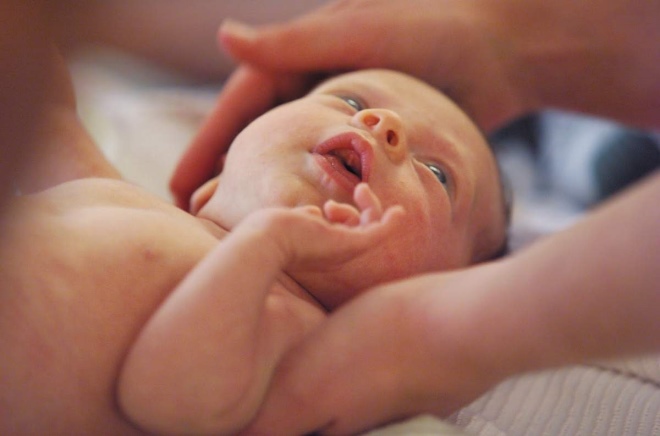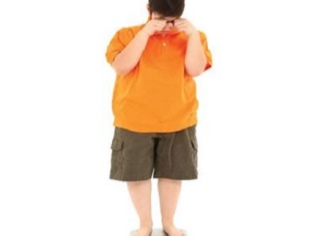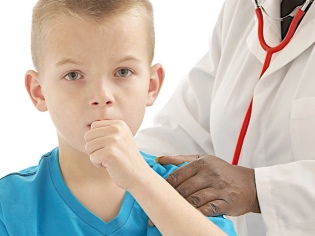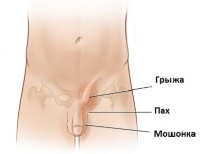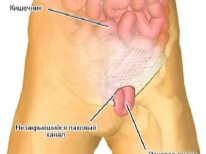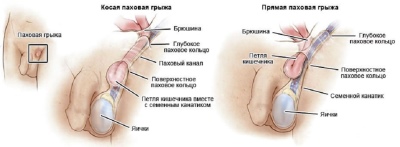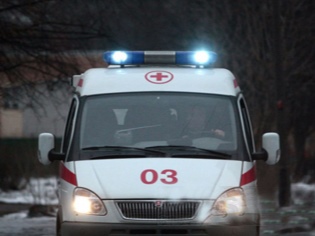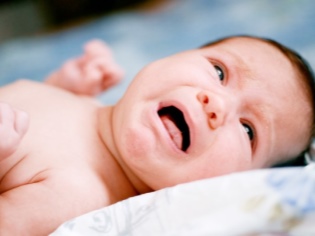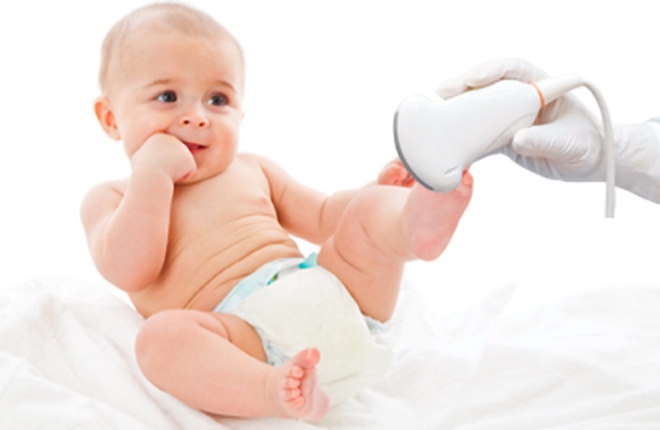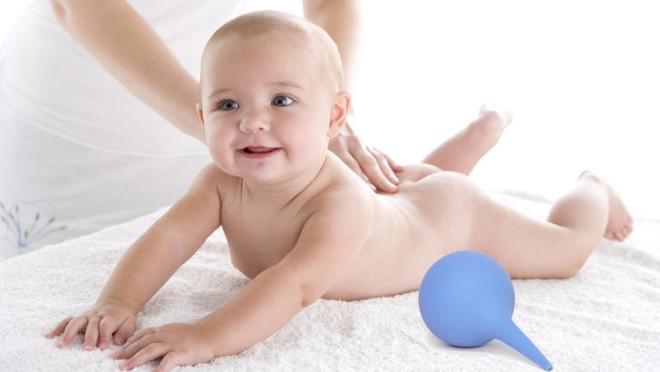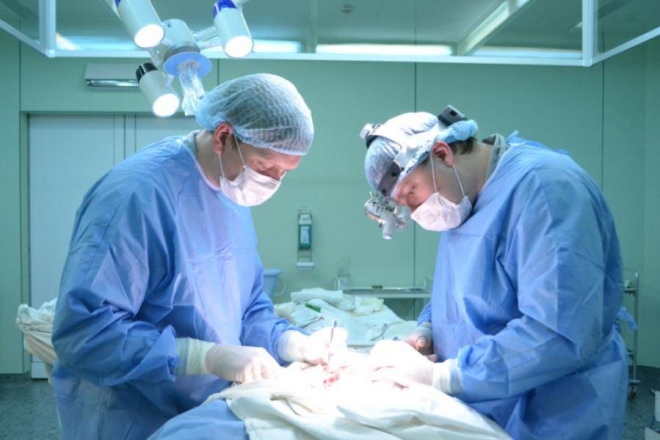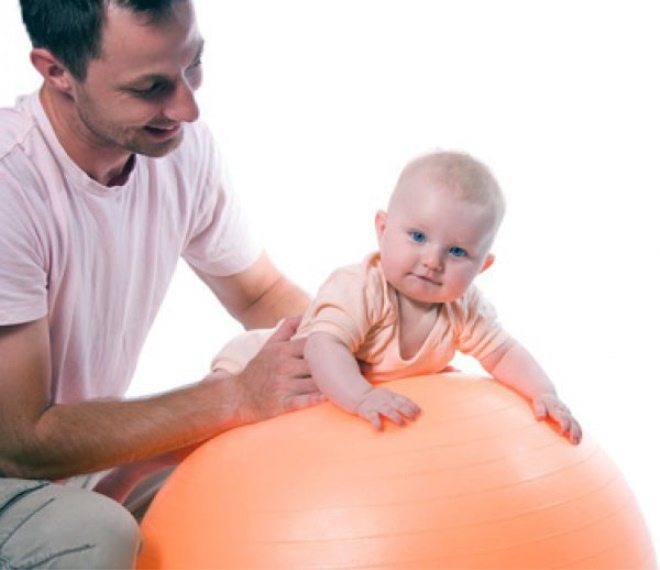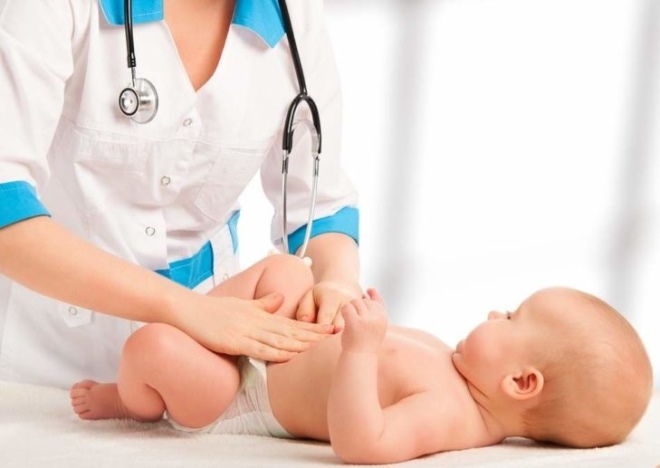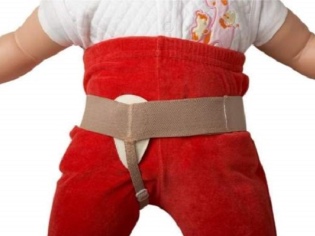Inguinal hernia in children
One of the most common abdominal abnormalities in children is an inguinal hernia. Usually, it is found at an early age, and parents are faced with the fact of the need for treatment. In this case, it is desirable to have a good idea of what exactly is happening with the child, and why it happened. In this article we will answer these and other questions.
What it is
Pediatric hernia in the groin is a condition in which the vaginal process of the peritoneum bulges out through the inguinal canal. What seeks exit through the inguinal canal is called the hernial sac. Inside it - parts of the internal organs, such as the bladder or intestines. The inguinal canal is a small gap that runs in the groin between the muscle tissue and ligaments. Inside the gap in female children is a round ligament of the uterus, and in boys there passes the spermatic cord.
According to statistics, hernia formation in the groin is most often found in boys. The risk of such an illness among them, according to various estimates, reaches 25-30%, whereas for girls it is only about 3%. According to pediatricians, for every girl with such a diagnosis, there are 6 boys with a similar problem.
In premature babies, the risk of an inguinal hernia is significantly higher than that of the crumbs that were born on time. The risk of development in the first - at least 25%, in children who appeared on time - 5%.
Causes of
Hernia disease in the groin is considered congenital, forms acquired - this is the lot of adults and the elderly. In boys and girls, the prerequisites for the appearance of bumps in the groin area are always created when they are in the mother’s stomach.
In future boys, during the embryonic period, the testicles form in the stomach. They start to go down to the inguinal canal only at 5-6 months of pregnancy. At the same time, they somewhat "tighten" the peritoneum. Finally, the testicle descends closer to childbirth, at the 9th month of pregnancy. The same utyatny pocket from the peritoneum, which was formed as a result of omission, and is called the vaginal process.
Normally, it drags on completely by the time the boy is born. If for some reason this does not happen, the communication of the inguinal canal with the abdominal cavity remains open. This can lead to the fact that along the way, which passed the testicle, the intestinal loop or another internal organ can set off. That is what will be a hernia in the groin.
If with boys everything is more or less clear, then with the mechanisms of the appearance of a hernia in girls usually have more questions. The answers lie in the anatomical features of the female embryo. In girls, the uterus is also not in the beginning from the very beginning. At first, this important reproductive organ is laid and formed much higher than it should be. And then, from about 4-5 months of pregnancy, the uterus begins its way down, in the same way, dragging along part of the peritoneum.
Behind it remains a similar vaginal process. And if by the time of birth the message with the abdominal cavity is closed, the exit of the hernial sac is not excluded. Thus, it becomes clear why in premature babies inguinal hernias are five times more common than in full-term ones.
But the risk of occurrence and the hernia itself as a fact is not the same. The risk may be, but there is no hernia.
The most common reasons why the hernial sac still bulges out are as follows:
- genetic predisposition to weakness of the peritoneum;
- cystic neoplasms of the spermatic cord;
- hydrocele (dropsy testicle);
- hip dysplasia;
- spinal cord hernias, back problems.
Hernias later (after 9-10 years) appear in the groin very rarely, and their root causes may be different than in newborns and infants. With the innate predisposition described above, inguinal hernias can appear in children with severe obesity, in children who lead an inactive lifestyle, move little, do not play sports, in those who suffer from frequent and severe constipation, as well as respiratory diseases associated with with severe chronic cough.
Classification
Depending on which side a hernia appeared from, it is qualified as right-sided or left-sided. Right-sided boys are more often, little princesses suffer from such a localization of the hernia sac infrequently. Hernial lesions in the left inguinal region are recorded in one third of all cases.
From two sides at the same time a hernia in the overwhelming majority of cases appears in girls. Bilateral hernia in male children is found in about 12% of cases.
Like many other hernial formations, the inguinal are also divided into oblique and straight. Oblique enter the inguinal canal, completely repeating the path of the testicle in perinatal age - from above with the passage through the inguinal ring. Hernia of the direct type in children occurs very infrequently, with them the bag of hernia goes out through the peritoneum.
For boys, a separate type of disease stands apart - scrotal or inguinal-scrotal hernia.
By mobility or immobility of the bag are distinguished:
- restrained hernia;
- elastically restrained hernia;
- Hernia with fecal pinching:
- hernia with Richter's pinching (parietal pinching of the bowel loop);
- hernia with retrograde incarceration (if two or more organs are pinched);
- unlimited
It is possible to reintroduce exclusively non-restricted inguinal hernia. All types of pinching are subject to treatment with the use of operative surgical procedures.
Dangers and complications
The main danger of an inguinal hernia lies precisely in the probability of its infringement. What it will be - no one can predict. When fecal type of pathology infringement occurs due to overcrowding of the intestinal loop, which fell into the bag, fecal masses, with retrograde - not only the intestinal spriticle, which is in the bag, but also the intestinal bruise, pinched.
In all cases of pinching, the child needs immediate and urgent surgical care. Whatever the type of development, infringement is associated with insufficient blood supply in the clamped organ, which rather quickly (sometimes within a few hours) can lead to tissue death, necrosis. Even in our developed age with operative medicine, doctors register cases of gangrene of strangulated organs in 10% of cases. Approximately 3.9% are due to deaths, with gangrene mortality is higher - from 20 to 35%.
Infringement is always acute. There is a strong unbearable pain in the groin, nausea, and sometimes repeated vomiting, the hernia becomes unmanaged, and the deterioration of well-being increases very quickly. Procrastination and self-medication attempts are dangerous. It is urgently necessary to deliver the little patient to the surgical hospital.
In fairness it should be noted that in childhood most of the inguinal hernias are not complicated by infringement. But the parents of a child who has been diagnosed in this way and who cannot decide on an operation should also be prepared for such a turn of events. The older the child becomes, the higher becomes the risk of pinching.
Symptoms and signs
Acute condition associated with infringement, it is easy to diagnose.It is much more difficult to find an inguinal hernia before it is complicated by incarceration. The fact is that the only symptom is an education in the groin of the hernia itself. It looks like a seal round or irregular in shape, slightly protruding.
The easiest way to notice the pathology in children. For example, in babies up to one year old, a child whose parents regularly dress, bathe, a hernia will be visualized in moments of strong crying, crying, during coughing. In a quiet state, when the child does not strain the abdominal wall or there will be no hernia noticeably in the dream.
The location of the bag in scrotal hernia in boys - inside the scrotum, so it will be deformed. In girls, the hernia usually prefers to descend into the labia, as a result there is a strong increase in one of the labia compared with the second. With bilateral pathology - both lips will be unnaturally large.
In children 5-6-7 years old and older, finding a hernia is more difficult, because parents no longer have access to all parts of the body of the child for ethical reasons. But such children can say with words that they are concerned. Without attention, one should not leave complaints about a nagging pain in the lower abdomen, as well as pain and a feeling of bursting in the scrotum and groin after a long walk, run.
Unreduced hernia should not greatly disturb the child.
Symptoms that should prompt parents to send their child to the hospital are:
- bloating of the abdomen, the absence of discharge of gas;
- strengthening the nature of pain in the groin area - from tingling and pulling sensations to acute pain;
- the hernial sac becomes stiff, tense and immobile, and touching it causes severe pain in the child.
Diagnostics
Usually, an inguinal hernia can be detected in the first months of a child’s life. Often it is found by the parents themselves, in other cases - the pediatric surgeon at the next scheduled examination in the clinic. Examine a child from birth to 1 year taken in a horizontal position.
Children who have already turned 2 years old can be examined in a standing position, with a mandatory assessment of the hernia when the body is tilted forward. For children who have already turned 4 years old, the surgeon will give one more “task” - to cough, as with a cough reflex it is possible to examine the hernia in more detail and assess its size.
The doctor will compare whether the testicles are symmetrical in boys, what is the shape and size of the girl's labia, Then the doctor gives a direction for an ultrasound. Boys do ultrasound of the inguinal canal, girls - ultrasound of the pelvic organs and abdominal cavity. Boys additionally prescribed diaphanoscopy of the scrotum. This procedure is simple and painless, it is to assess how the body is able to pass through the rays of light. This method allows you to set or disprove dropsy testicles as a possible root cause of the appearance of a hernia in the groin.
When the ultrasound shows that a part of the bladder has sunk into the hernia sac, a cystography will be assigned - a procedure in which a special substance is injected into the bladder, which is then clearly visible on the X-ray, this allows a detailed examination of the condition of the clamped organ. Irrigoscopy is prescribed if it is determined by ultrasound that there is a bowel loop in the contents of the bag. Using an enema, the child is injected with a contrast solution into the rectum, after which an x-ray is taken to evaluate the characteristics of the strangulated organ.
Treatment
Regarding inguinal hernias, doctors are usually quite categorical and offer surgical removal of the hernia sac as a treatment. Indeed, there are risks of complications, and to save a hernia by and large there is no point.
The inguinal hernia will not pass on its own, as it happens with umbilical in babies.
The vaginal process by itself, by analogy with the umbilical ring, will not linger or overgrow.If this did not happen at the time of birth, then doctors should act further. Sticking plaster, hope for the help of a special bandage, do not, you need to do the operation. The operation called “herniosis” is the only possible solution to the problem. However, statistics show that about 10% of patients after such surgery experience genitofemoral pain syndrome. That is why children with unrestricted hernias of small sizes are given a “delay” by choosing a method of watchful waiting.
The operation itself is considered not the most difficult; even a novice surgeon can perform it. (this is what often happens in reality, it is precisely in hernia repair that the first "baptism of fire" of yesterday's graduates of medical schools receive). Therefore, parents who, naturally, are worried about the consequences of surgical intervention, should ask the qualifications of a specialist before performing a planned operation. Children operation is performed under general anesthesia. First, doctors access the inguinal canal through an incision, then find the hernial sac and remove it. After that, the inguinal canal is sutured to a normal, natural size, and in case of its destruction, the canal plastics are made.
A hernia can be closed with a mesh, if it was able to be set during the operation and do without removal. Operations often try to carry out the incompetent method. To do this, use the capabilities of laparoscopy. Laparotomy (abdominal incision) is performed only when part of the intestine is not viable due to the incision of a hernia and needs to be removed. After laparoscopic surgery, children quickly come to their senses, after a few hours they get up, the recovery period is short. The probability of recurrence is about 1-3%. Uncomplicated small hernia in the groin of children are removed according to plan, they can be discharged home after 3-4 hours in a normal state of health.
Doctors evaluate forecasts as conditionally favorable. If the operation was carried out correctly, and the patient will subsequently comply with all appointments, it will be possible to forget about the inguinal hernia for the rest of your life.
Rehabilitation recommendations
After the operation, physiotherapy exercises are shown to the child in about a month. You can do it on the basis of the exercise therapy room in the clinic at the place of residence. Exercises with balls, sticks, at the gymnastic wall are designed to help the child get back to normal life as soon as possible. In addition, such physical culture accelerates the process of tissue regeneration in the surgical area, improves homeostasis, strengthens the muscles of the abdominal wall.
To the complex of exercises necessarily add breathing exercises. 3-4 weeks after the operation, the child can go in for active walking (sports), ski, go to the pool. Massage during this period is aimed at preventing violations of intestinal motility, strengthening the abdominal muscles. To do this, the child is massaged back along the spinal column, perform massaging circular movements in the abdomen, around the navel, and stroke the oblique abdominal muscles. You should always complete the massage with the lower part of the body, stroking and then kneading the legs.
The special restraints that are worn after the operation - bandages will help the child and protect from possible relapses. Children's bandages are not similar to adults, you need to buy them in specialized orthopedic salons, having first asked the size and other design features of the product from the attending physician.
Bandage after surgery to remove an inguinal hernia can be:
- left sided;
- right sided;
- two-way.
To the bandage in the set there are special inserts that are fixed on the place where there was (or is) a hernia. It should be understood that such orthopedic devices cannot cure a hernia in the groin; they only support the hernia sac from falling out and slightly reduce the risk of infringement. That is why we placed the information about bandages in the section on rehabilitation.
Reviews
Problems of diagnosis and treatment of an inguinal hernia in a child are discussed in numerous parental forums on the Internet. Most moms and dads say that older children more easily tolerate hernia surgery, and the next day they are actively moving. Mothers of babies up to a year claim that they were discharged from the hospital a little later than older children, but no later than 4-5 days. It is advisable to take disposable diapers with you to the hospital, they will be useful to the child after the operation, when he cannot rise, and drinking water without gas.
Parents practically do not complain of relapses after the operation, but there are complaints about diagnosticians. Quite often, according to reviews, when a child is hospitalized according to plan for an operation with one hernia, surgeons already find two or even three hernia sacs in the operating room. Some children will be immediately removed and the groin, and umbilical hernia. This does not adversely affect the state of health after the intervention, but requires a slightly different, expanded set of measures in the rehabilitation process.
The pediatric surgeon Aleksandr Ivanovich Sumin will tell you about the dangerous inguinal hernia in the next video.




